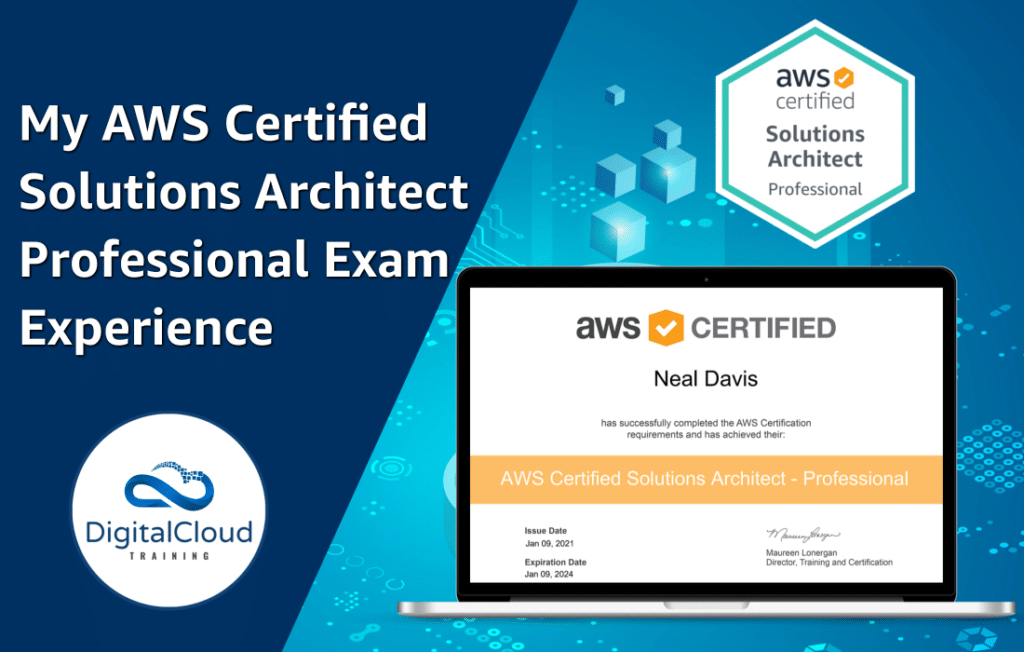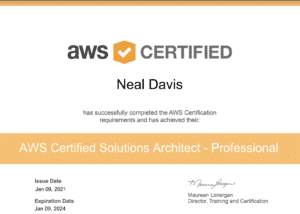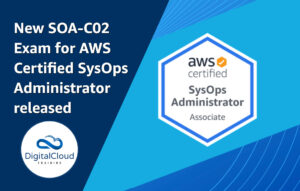My AWS Certified Solutions Architect Professional Exam Experience
Please use the menu below to navigate the article sections:

The AWS Certified Solutions Architect Professional certification is one of the most sought-after qualifications in Cloud Computing today. A large number of people currently hold the foundational and associate-level certifications, but the number becomes much smaller for the professional level. And there’s a good reason for this. The AWS Certified Solutions Architect Professional exam is a very challenging exam that really tests deep AWS knowledge and experience of how AWS services can be used together.
The AWS Certified Solutions Architect – Professional (SAP-C01) exam is structured with:
- 75 multiple choice and multiple response questions
- 180 minutes completion time
- 75% pass mark
With a little bit of easy math, you can quickly work out that you have around 2 1/2 minutes to complete each question. For easier certifications that might be plenty of time but if you’ve seen examples of professional-level AWS exam questions you’ll know they can be long and complex. With a higher pass mark than the associate levels too, this makes passing this exam a challenging experience.
Click the image above to watch Neal share his AWS SAP-C01 exam experience on our YouTube channel
My Experience of the SAP-C01 Exam
In this blog post, you’ll learn what to expect, and I hope to encourage you that though it may sound very challenging (and it is), it’s absolutely achievable with the right preparation. I recently passed the exam with 945 points out of 1000 so with just a few errors out of 75 questions, I’m pretty happy to say I passed with a solid margin. With the right hands-on training and practice tests, this could be you next:

We’ve just released a new practice test course and hands-on video training for the AWS Certified Solutions Architect Professional! With the help of this ultimate training package, you’ll be armed with the best and most up-to-date resources available so you can smash your exam.
I’ll now provide an overview of the exam and start by looking at the question types you’ll see on the exam and the topic of time management (super important), before moving on to look at the actual content of the exam in more depth.
Question Types
The AWS Certified Solutions Architect – Professional (SAP-C01) exam guide lists two types of questions that are on the examination:
- Multiple choice: Has one correct response and three incorrect responses (distractors).
- Multiple response: Has two or more correct responses out of five or more options.
In reality, what you’ll find is there are mostly three different broad styles of question: questions with 1 correct answer, questions with 2 correct answers, or questions with 3 correct answers. You can expect about a dozen or so questions with two answers and half a dozen with three answers on average. Don’t get too concerned about the number of answers you have to give, it’s not a good indicator of question difficulty. If anything, I have found that the questions with three answers can sometimes be the easiest to answer (not always the case though!).
For the professional level questions, you also need to be aware that there will often be multiple correct answers and you must choose the best answer based on the criteria defined in the question. For example, the question may ask you to choose the most cost-efficient option, the option that requires the least operational or maintenance effort, or the answer that offers the greatest availability or the strongest performance. Always make sure you’re clear on exactly what the scenario is calling for.
Question Length
If you’ve seen examples of the AWS Certified Solutions Architect Professional questions, you’ll know they can appear quite intimidating. Questions can be either quite long or quite short. The answers can also be lengthy or brief. This is another example of where you need to bring the right mindset to the exam. Try not to be concerned by how long the question is as longer questions and longer answers often provide more clues that can help you to make the best choice.
Also, try and filter out the fluff, the longer questions often have some superfluous information that does not directly influence the answer. Learn how to identify the key information and requirements and quickly extract what you need to make your choice.
Time Management
This is one of the most important factors for success. You need to be very conscious of the clock. The last thing you want is to get down to the last few minutes and find you still have a number of tricky questions to answer! Being conscious of time and ensuring you don’t have to rush towards the end can have a positive impact. We tend to make more mistakes when we’re stressed under time pressure.
It’s important to note that the difficulty level of the questions can vary quite widely. I found myself quickly moving through many questions and then needing to spend a few minutes on individual questions that were more ambiguous or difficult to answer.
Another tip is to try not to spend too long on questions where you feel torn between answers. Think it through carefully, make your selection, and mark for review. You can then go back at the end of the exam and spend a bit more time and under less pressure. At the end of my exam, I still had around 30 minutes to go back and check some of the answers I had marked for review.
The Exam Domains
The AWS Certified Solutions Architect Professional exam includes 5 domains:
- Domain 1: Design for Organizational Complexity (12.5%)
- Domain 2: Design for New Solutions (31%)
- Domain 3: Migration Planning (15%)
- Domain 4: Cost Control (12.5%)
- Domain 5: Continuous Improvement for Existing Solutions (29%)
As an architecture exam, AWS strongly test your ability to choose the best solutions for various scenarios relating to performant, reliable, available, and secure solutions. In this exam, expect scenarios to include multiple accounts and multiple region architectures. You’ll also need to find solutions to reduce complexity, optimize existing architectures for improved availability or reduced cost, and migrating on-premises solutions into the cloud.
Topics and Tips for the AWS Certified Solutions Architect Professional exam
The AWS Certified Solutions Architect Professional exam is both broad and deep. It covers a large number of AWS services and can require deep knowledge of quite a few of them. One of the most important skills with this exam is knowing how AWS services work together to form solution architectures. Knowledge of the factors that influence design decisions when using multiple service solutions architectures is key to passing this exam. This is one of the reasons why hands-on skills are extremely important for this exam.
Now let’s get into a bit more detail on the topics you’re likely to see come up on your exam. These aren’t specifically topics that came up on my exam (I’m bound by the Candidate Code of Conduct), but they are common topics that come up in the SAP-C01:
Compute:
- When to use an NLB vs an ALB, e.g. requirement to whitelist IP addresses.
- Which compute pricing models to use for a given scenario.
- How to scale for performance – Amazon EC2, AWS Lambda, Amazon ECS options.
- Deployment options for Auto Scaling with instances, containers, and serverless.
- Refactoring applications to microservices or serverless architectures.
Storage:
- Choose the best storage architecture for given requirements, object, block, file, HPC use cases etc.
- Amazon S3, Amazon EFS, AWS Storage Gateway, Amazon FSx (for Windows File server or Lustre).
- Performance characteristics of different storage options, tiers, classes and volume types.
Database:
- When to use relational vs non-relational databases – Amazon DynamoDB, Amazon Aurora (comes up more than RDS now)
- How to refactor existing databases to AWS managed services.
- Using caching solutions for performance – DynamoDB DAX, Amazon ElastiCache
- Scaling read performance, multi-AZ, multi-Region and multi-active databases.
- Using data warehouses (Amazon RedShift) and graph DBs (Amazon Neptune).
Migration and Transfer:
- How to use the Application Discovery Service to plan migrations.
- Migrating from on-premises Microsoft Hyper-V, VMware, and physical servers.
- Using the Migration Hub.
- Migrating with AWS SMS, DMS, SCT and DataSync.
- When you need to convert schemas with SCT, e.g. Oracle to DynamoDB.
- When you need to use the Snow family of devices vs online migrations.
Networking and Content Delivery:
- Solid familiarity with Amazon VPC including IP CIDR blocks, subnets, and route tables.
- When to use a NAT Gateway or NAT instance and how to deploy properly.
- VPC endpoint architecture and how to deploy gateway and interface endpoints.
- Using policies to restrict access through endpoints.
- Security group and NACL best practices and use cases.
- Route 53 for resolution and traffic direction. Must know the routing options and use cases.
- When to use AWS Direct Connect and how to deploy redundantly (and how to add encryption).
- Architecture and use cases for AWS VPN, AWS Transfer Gateway, and AWS Direct Connect gateway.
- API Gateway deployment options and performance optimizations.
- AWS Global Accelerator and Amazon CloudFront – know the use cases and differences.
Developer Tools:
- Understand the whole CI/CD pipeline and how each tool fits in – AWS CodeBuild, CodeCommit, CodeDeploy, CodePipeline.
- How to implement a CodePipeline with Github (webhooks) and Jenkins and other similar tools.
- Tracing with AWS X-Ray.
- Understand the various deployment options and when to use them, e.g. in-place, all-at-once, canary, blue/green.
Management and Governance:
- AWS Organizations SCPs – know the whole structure of applying SCPs and the inheritance (worth lots of points!).
- Know your CloudFormation and how to use StackSets and Change Sets.
- AWS Auto Scaling for relevant services.
- Know what metrics you can get with CloudWatch and when you require custom metrics.
- Know what to capture with CloudTrail and how to use EventBridge or CloudWatch Alarms / Events to react.
- Systems Manager Parameter Store use cases, and patching services.
- Service Catalog and how to share portfolios in AWS Organizations.
- OpsWorks use cases and deployment options.
Machine Learning:
- A few random questions include things like Transcribe and Rekognition – just know what these services are used for and how they can fit into solution architectures.
Analytics:
- Know how to analyze data from various sources such as datalakes on S3 or Kinesis Data Streams.
- Athena, RedShift, EMR, Elasticsearch, Kinesis, QuickSight, AWS Glue.
Security, identity and compliance:
- Know your IAM policies well.
- How to enable cross-account access with roles + external ID.
- AWS Directory Service.
- Secrets Manager use cases.
- AWS Single Sign-on and Cognito – know use cases for these.
- KMS, Certificate Manager, CloudHSM.
- Implementing AWS WAF – know what you can do and to what types of resources you can use it with.
- Defence in depth using WAF, security groups, NACLs and other security measures.
- Using Shield and other DDoS mitigation techniques.
Front-end Web and Mobile:
- Use cases for AWS AppSync.
Application Integration:
- Know when to use each service including SQS, SNS, SWF and Step Functions.
- Use cases for Amazon MQ such as migrating existing applications using these protocols.
- Amazon EventBridge for coordinating message flows between services.
- Scaling options with ASG and SQS.
Cost management:
- Using AWS Organizations for centralized billing.
- Cost allocation tags.
- How to report on costs for individual cost centers.
- Using different savings plans and reservation options.
End-user computing:
- WorkSpaces and AppStream – know what these are.
Internet of things:
- IoT Core deployment options and use cases.
FAQ
Can I pass the AWS Certified Solutions Architect Professional exam without hands-on experience?
- Yes, this is definitely possible and I have many students who have done this. However, it will definitely make it considerably harder. AWS recommend two or more years of experience for candidates and though you can certainly get by with less than this, it’s strongly recommended to get as hands-on as you can. So make sure you use a hands-on training course and sign up for our Challenge Labs.
Are there any prerequisites to taking the exam?
- No, there are no longer any prerequisites. I would recommend that if you don’t have very strong industry experience working with AWS services, you should definitely do the AWS Certified Solutions Architect Associate at a minimum. My best recommendation is to do all associate-level certifications first – as the knowledge gained will be extremely useful.
Can this exam be taken using from my home or office with online proctoring?
- Yes, you can take the AWS Solutions Architect PRO exam from home (that’s how I took it). You must use Pearson VUE and make sure you check the requirements for taking the exam from home. You must have a good internet connection and a quiet clutter-free space. You also cannot leave the exam at any point (3 hours!).
Ready to Take Your Tech Career to the Next Level?
- On-Demand Training: Learn at your own pace and on your own schedule.
- Challenge Labs: Apply what you’ve learned in a real-world setting without the risk of incurring surprise cloud bills.
- Cloud Mastery Bootcamp: Build job-ready skills with this live, immersive training that can get you certified faster than you thought possible.




